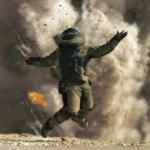Addicted to Danger
 There is no question that being shot at, and missed, creates a euphoria that is hard to explain. In The Hurt Locker, war is depicted as a “drug” for some -- a high that is addictive.
There is no question that being shot at, and missed, creates a euphoria that is hard to explain. In The Hurt Locker, war is depicted as a “drug” for some -- a high that is addictive.
If you want an idea of what the war in Iraq and Afghanistan is really like, go see the movie The Hurt Locker.
A lot of deserved publicity has accrued since it won the Academy Award as the year’s best movie, and especially for Kathryn Bigelow as the first woman to win an Oscar for directing – this latter, even more remarkable considering the
topic of her movie.
To me, The Hurt Locker is in the company of the five-part TV series, Band of Brothers which, arguably, is the finest war movie ever made – following the exploits of a company of the 101st Airborne Division in the war against Hitler.
It superbly captures the daily life of soldiers: The wry humor, camaraderie, the intuitive cooperation of soldiers in battle, the fear, the hurt, the fatalism. The Hurt Locker does the same for the Americans in Iraq, and also Afghanistan.
This is a war movie with a difference – perhaps because the director was a woman who avoided the pitfalls of being either anti-war or glorifying battle. Its purpose is to show what the war in Iraq (and now Afghanistan) means to soldiers.
The movie is not especially bloody. Rather, it is tense. In fact, I can’t recall a movie where the tension is so acute. For people who have never been in the situation of the three Bravo Company soldiers, the film enables viewers to experience some of what the soldiers endure. It is harrowing.
The movie is about a three-man team locating and disarming roadside bombs and IEDs. One of the soldiers has a hard time coping with the war and needs reassurance. Another is like most soldiers, competent, dutiful but not anxious to take unnecessary risks. He is everyman.
The team leader is gung-ho, ever-seeking an adrenalin fix, getting high on danger, pushing his team into situations they don’t want to go. From considering fragging him for putting them in danger, they come to respect him while never understanding his obsession with taking risks.
And that’s a significant part of the movie – the narcotic of danger. War is depicted as a “drug” for some - a high that is addictive. It’s a quality not unknown to journalists who attend wars, and especially combat photographers who take extraordinary risks to get a photo.
I think of French Paris Match photographers in places like Vietnam, Algiers, the Congo as being recklessly brave, and very dangerous to be around.
That said, there is no question that being shot at, and missed, creates a euphoria that is hard to explain. In The Hurt Locker, the relationship of the soldiers after the tension of defusing bombs, is intense in a relaxing way that builds the bond that makes them good at their job.
The movie is effective in that there is no end to danger. There’s always another IED. Relaxing is tough. Bombs may be set with timers – or exploded electronically by cell phones. Always with Iraqis in buildings watching, videotaping, plotting. More tension to the breaking point.
These guys are insanely brave.
They are like Canadian Combat Engineers who daily defuse bombs – and periodically miscalculate. But it’s what they do.
The movie starts with 38 days left before rotation home. They finally make it. The movie ends with the prime hero, the gung-ho sergeant, back in Iraq with Delta Company with 365 days to go before rotation – he can’t endure the normality of civilian life.